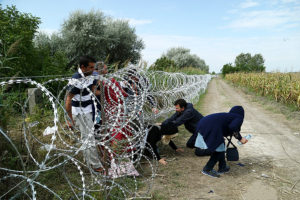And the Walls Came Tumbling Up
 When the people of Berlin dismantled the Berlin Wall in 1989, they removed a structure which stood for decades as the physical manifestation of the divided Cold War world. Scholars such as Francis Fukuyama spoke of a new age of global connectivity and the eventual triumph of an open, liberal, democratic world. As Fareed Zakaria noted, the end of the Cold War brought the end of “traditional barriers to the flow of money, trade, people, and ideas.”
When the people of Berlin dismantled the Berlin Wall in 1989, they removed a structure which stood for decades as the physical manifestation of the divided Cold War world. Scholars such as Francis Fukuyama spoke of a new age of global connectivity and the eventual triumph of an open, liberal, democratic world. As Fareed Zakaria noted, the end of the Cold War brought the end of “traditional barriers to the flow of money, trade, people, and ideas.”
Today, however, populist movements on both the left and right seek to reverse this openness. In the U.S. this phenomenon is embodied by presidential candidate Donald Trump, who proposed building a border wall in order to keep Mexican immigrants out of the country, erecting tariffs on China, Mexico, and Canada, removing the United States from NAFTA, and opposing the Trans Pacific Partnership (TPP). Each of these proposals represents a barrier between the United States and the rest of the world and undermines the economic system developed after the collapse of the Soviet Union. These positions reflect the underlying opposition to globalization that exists within some parts of the American electorate.
America is not alone. Europe, too, has seen a rise in anti-globalization sentiment, in large part due to the Syrian refugee crisis. In Hungary, the government plans to build a wall along the country’s border with Southern Europe in order to stem the flow of migrants entering the country. Bulgaria built a wall last April for similar reasons. The UK also seeks to prevent migrants from entering the UK by partnering with France to develop a wall in Calais. Latvia, too, has plans to develop a wall along its border with Russia to prevent the arrival of illegal immigrants from Central and East Asia.
Furthermore, Europeans are divided on the issues of free trade and the EU. An obvious example is Brexit, in which UK voters chose to leave the European Union largely because of opposition to immigration, EU economic policies, and perceived European infringement on British sovereignty. Trump supporters, it seems, are not alone in wanting to “take their country back.” Other populists such as Marine Le Pen of France seek to further dismantle the EU by pushing for referendums in several other European countries. European trade negotiators have also dealt with increasing backlash against the Transatlantic Trade and Investment Partnership (TTIP), a developing trade agreement between the United States and the European Union.
The development of walls is not solely limited to the West. In the Middle East, the rise of ISIS and worsening humanitarian crises led some countries to place new restrictions on travel. Last year Saudi Arabia announced a plan to build a 600-mile wall in an effort to keep out ISIS and restrict the movement of people into Saudi Arabia. U.S. officials are currently working with the Jordanian government to create an electric fence along Jordan’s northern and eastern borders in order to reduce the flow of refugees and protect an American base. This reflects a broader trend in the Middle East: limiting access through visa restrictions, refusing to legally register refugees, and other methods. Although some countries, such as Jordan and Lebanon, have taken in millions of refugees, these legal barriers do more than any physical wall in worsening the plight of those fleeing war-torn nations.
It is impossible to know if this renewed international love for barriers will develop into a new global retrenchment echoing the era of the Great Depression, or if it will end as a populist blip in history. Regardless, if left unresisted, these barriers will prove harmful to economic growth and bring racist sentiments into mainstream thought. Globalization is an ultimately fragile trend that can be undermined with victories by isolationist and populist forces. If the international community ignores these trends, the era of openness that Fukuyama and Zakaria envisioned will cease to exist.
